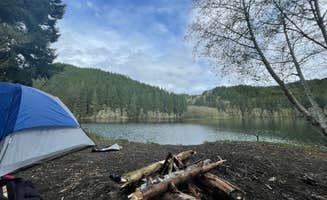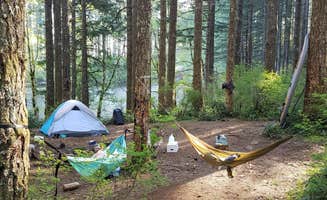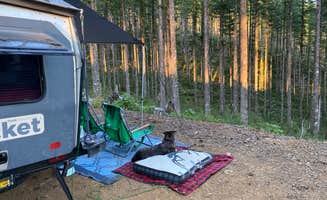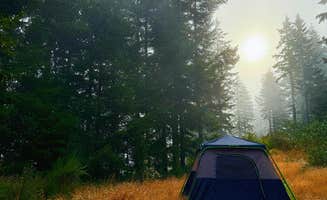Primitive camping near Blodgett, Oregon primarily occurs within the Siuslaw National Forest at elevations ranging from 800-3,000 feet, creating varied terrain and forest density. The area receives approximately 70-100 inches of annual rainfall, resulting in lush forest undergrowth during spring and summer. Many dispersed sites remain accessible through mid-November before seasonal closures affect higher elevation access points.
What to do
Kayaking on small lakes: At South Lake, visitors can enjoy paddling in a sheltered forest setting. "This free campground is just far enough out from the coast and the city that you'll likely be alone, even on a Saturday night. Most folks coming to this area of the forest camp in the more popular (and more expensive) Hebo Lake campground," notes Chris H.
Fishing for stocked trout: Several forest ponds offer fishing opportunities without requiring long hikes. "We caught trout every day we were there. Most are small but was fun nonetheless. There is an old boat without a motor tied up for anyone to use," reports Gerard R. about his experience at South Lake.
Hiking to viewpoints: The Mount Hebo area provides trail access with coast views on clear days. "Going up the hike about 30 minutes will bring you to the top of Mt. Hebo with beautiful open views all the way to the coast. The hike goes all the way to South Lake," explains Sarah S. about trails near the Pioneer-Indian Trail dispersed sites.
What campers like
Solitude and minimal crowds: Many backcountry sites near Blodgett remain relatively undiscovered. "We didn't pass a single car the rest of the way. We missed the turn off originally but saw empty spot from the road after driving on a few minutes," reports Josie M. about Pioneer-Indian Trail camping areas.
Wildlife viewing opportunities: The forest setting provides chances to observe native species. "I did see about 5 beavers close to the road though, so that was sweet. By far one of my favorite campsites I've been to," shares Dylan B. from Forest Road 51 near Beaver Creek.
Stargazing in remote locations: Many primitive sites near Blodgett offer minimal light pollution. "We found a spot at the end of the road that opened up a little bit more than other sites. There were others around here and not a huge amount of site options, so be weary of spaces filling up," notes Emma T. about Forest Road 51 camping options.
What you should know
Road conditions vary significantly: Many access roads deteriorate after leaving main routes. "Road to get there was about 12 miles of dirt/gravel but when I left, only had dirt roads for 3 miles," explains a visitor about navigation to forest sites.
Cell service is inconsistent: Coverage varies even within short distances. "We lost cell service about an hour before we even got there, and didn't have any the whole time there. There are some really cool spots that were taken," writes Grace A. about her stay at Hult Pond.
Trash management responsibilities: Pack-out requirements apply to all dispersed sites. "They have a bathroom which is a plus but no trash cans so please whatever you pack in make sure to pack it out. Seeing trash in beautiful places always ruin it a little," advises Dax S. about Hult Pond protocols.
Limited turnaround space: Some narrow forest roads lack adequate space for larger vehicles to turn around. "If you go down the main lower path you will find a area big enough to u turn! Dont do it until then! Other wise a wonderful time," warns Dillon & Soren A. about Hult Pond access.
Tips for camping with families
Choose sites with toilet access: Some dispersed areas provide basic facilities. "Vault toilets were pretty clean. Didn't explore anything around as it was raining the entire time I was there. Quite a few hunters in the campgrounds," notes Abby M. about Kentucky Falls Road camping.
Plan for wildlife encounters: Teaching children about wildlife safety is important. "There was a bear in the morning which was cool," reports Ashley L. about camping on forest roads near Mount Hebo.
Pack extra water: No potable water exists at dispersed sites. "About an 1 hour from Corvallis but worth it if you can go at a good time! No service but great from a seclusion! So remember all games and firewood you need!!" advises Chloe about preparation for Hult Pond.
Consider seasonal timing: Spring and fall offer fewer insects than summer months. "I went during my spring break and I was lucky that it was too cold for most people to camp there. It was beautiful and quiet (other than the 9pm daily goose choir)," shares Nicki G. about Hult Pond conditions.
Tips from RVers
Length restrictions matter: Forest roads often limit RV size possibilities. "Narrow and unpaved road. Vert narrow, My trailer could barely fit through and there was only a three-way intersection inside to make a U-turn, otherwise my trailer wouldn't be able to get out!" warns Leo Y. about Forest Road 51.
Scout before committing: Checking sites before bringing in larger vehicles prevents complications. "If you're telling something, I'd recommend walking the road to check to see if anybody is down there before you go down because it's the only place you'd be able to turn around with your trailer," suggests Craig R. about Pioneer-Indian Trail sites.
Consider inclement weather effects: Weather significantly impacts road conditions. "Not a good idea to attempt in inclement or muddy weather due to exposed road along some stunning stretches high above the forest," cautions a visitor about Forest Road 55.
Watch clearance on unmarked obstacles: Many forest routes have unmarked hazards. "It's very pineconey and pebbley driving in but the road is super super short! There is plenty of turn around room at the end too!" notes Josie M. about Pioneer-Indian Trail access.






